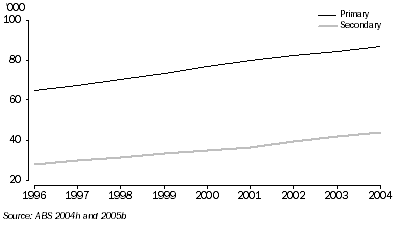There was a steady increase in the number of full-time Indigenous students attending primary or secondary schools between 1996 and 2004 (graph 3.1). There were increases in every state and territory, with Australia-wide enrolments reaching 130,400 in 2004. The proportion of all full-time students who were of Indigenous origin also rose from 3% in 1996 to 4% in 2004. This reflects the increasingly younger age profile as a result of increased growth in the Indigenous population over this period; and the improved identification of the Indigenous status of students in administrative records.
3.1 Primary and secondary full-time school enrolments, Indigenous students - 1996-2004

School retention
A major focus of Indigenous education initiatives has been to encourage students to continue their education beyond the compulsory years of schooling in order to increase their future employment prospects and opportunities for non-school education.
The National Schools Statistics Collection showed that, in 2004, the apparent retention rate for Indigenous full-time students from Year 7/8 to Year 10 was 86% and to Year 12 was 40% (see the Glossary for more information on apparent retention rates).
Indigenous retention to Year 10 and beyond steadily increased between 1996 and 2004 (table 3.2). This trend was particularly evident at the Year 11 level, where the apparent retention rate from Year 7/8 rose from 47% in 1996 to 61% in 2004.
3.2 Apparent school retention rates, Indigenous full-time students - 1996-2004 |
|  |
 |  | 1996 | 1997 | 1998 | 1999 | 2000 | 2001 | 2002 | 2003 | 2004 |  |
 |  | % | % | % | % | % | % | % | % | % |  |
|  |
| From year 7/8 |  |  |  |  |  |  |  |  |  |  |
 | To year 9 | 96.5 | 96.4 | 95.0 | 93.9 | 95.5 | 96.5 | 97.8 | 96.8 | 96.5 |  |
 | To year 10 | 75.8 | 80.6 | 83.3 | 82.0 | 83.0 | 85.7 | 86.4 | 87.2 | 86.4 |  |
 | To year 11 | 47.2 | 49.6 | 52.3 | 56.0 | 53.6 | 56.1 | 58.9 | 61.4 | 61.4 |  |
 | To year 12 | 29.2 | 30.9 | 32.1 | 34.7 | 36.4 | 35.7 | 38.0 | 39.1 | 39.5 |  |
|  |
| ABS 2004h and 2005b |
While Indigenous retention rates remain considerably lower than those for non-Indigenous school students, the gaps between the two groups are slowly closing (table 3.3). In Year 11, the gap between Indigenous and non-Indigenous students closed by nine percentage points between 1996 and 2004. While the Year 12 gap closed by six percentage points over this time period, Indigenous students were still around half as likely as non-Indigenous students to progress to the final year of schooling in 2004.
Literacy and numeracy
In 1997, all Australian states and territories agreed to implement standardised benchmark testing in order to provide nationally comparable data on the literacy and numeracy of Australian children. As the benchmarks represent a minimum level of competence for literacy and numeracy at various grade levels, non-achievement of the benchmark indicates that the student will have difficulty progressing satisfactorily at school (MCEETYA 2005). It is important to note that students from low socioeconomic backgrounds and those who speak English as a second language are likely to be at a disadvantage during these standardised assessments (DEST 2003).
In 2002, more than three-quarters of Indigenous Year 3 students who took part in the testing achieved the reading benchmark (77%), the writing benchmark (77%) and the numeracy benchmark (78%). In Year 5, these rates were 68%, 76% and 66% respectively.
In 2002, fewer Indigenous students achieved the Year 3 and Year 5 benchmarks in reading, writing and numeracy compared with all students (table 3.4). The largest differences between Indigenous students and all students occurred at the Year 5 level in numeracy and reading.
3.4 Year 3 and Year 5 students, Proportion achieving benchmarks - 2002 |
|  |
 | Year 3 | Year 5 |  |
 | Indigenous | All students | Indigenous | All students |  |
 | % | % | % | % |  |
|  |
| Reading | 76.7 | 92.3 | 68.0 | 89.3 |  |
| Writing | 77.1 | 93.6 | 76.4 | 93.6 |  |
| Numeracy | 77.6 | 92.8 | 65.6 | 90.0 |  |
|  |
| MCEETYA, 2005 |
 Print Page
Print Page
 Print All
Print All